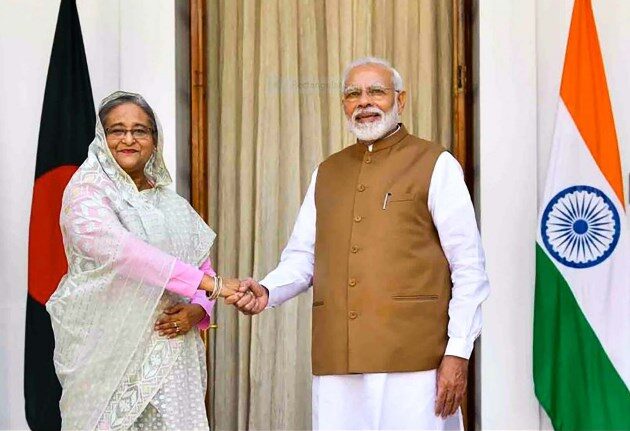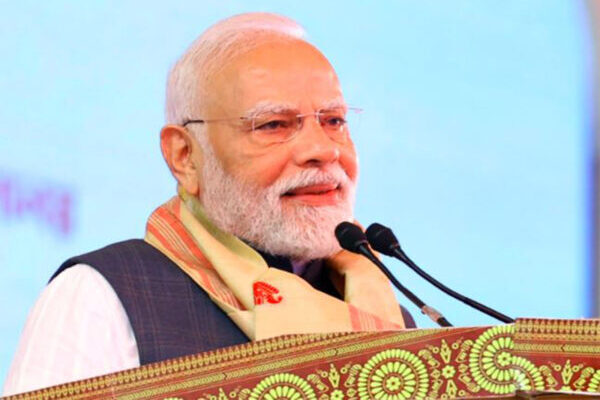
Prospects Of India-B’desh Comprehensive Economic Pact
Bangladesh-India relations enjoy cooperation and development in almost every area. Moreover, the relative success in economic advancement and strong pursuit of connectivity of both the countries have evoked to think about a comprehensive economic partnership as well.
As both the countries are experiencing high growth and stable rise, they have embarked on signing a comprehensive economic partnership agreement, which has been titled as Bangladesh-India Comprehensive Economic Partnership Agreement (CEPA), to reap the benefits of mutual trust and understanding in a range of bilateral issues.
It is timely as Bangladesh is going to come out from LDC and facing the challenges emanating from it. Over the past twelve years, the Bangladesh-India bilateral economic relationship has been going well and has entered a new terrain with the strengthening of traditional ties and foundations being laid to deepen and broaden the partnership in going forward. India is the second-largest trade partner of Bangladesh and Bangladesh is India’s biggest trade partner in South Asia. Bilateral trade between India and Bangladesh has grown steadily and the exports of Bangladesh have tripled over the last decade.
Notably, the talks on a CEPA began informally since 2018, in the backdrop of increasing Chinese investments in Bangladesh. It was also discussed due to the fact that regional free trade arrangements, like South Asian Free Trade Area (SAFTA), have become dysfunctional. Later, an expeditious commissioning of a joint study on the prospects of entering into a bilateral CEPA was devised during the visit of Bangladesh Prime Minister Sheikh Hasina in October 2019. The original timeline for completion of the joint study was September 2021. In addition, during Prime Minister Narendra Modi’s Bangladesh visit in March 2021, the two countries had agreed to enhance trade and the joint statement underscored the need for the removal of non-tariff barriers, need for predictability of trade policies, regulations and procedure, visit of a high-level team from Bangladesh from March 1-4, 2022 after a Joint Study Group (JSG) for examining the feasibility of the CEPA submitted its recommendations.
Understanding Comprehensive Economic Partnership Agreement (CEPA)
The proposed CEPA between Bangladesh and India has three dimensions, namely trade in goods, trade in services, and investment. The main target of the proposed CEPA is to reduce the huge trade gap between Bangladesh and India and open up new economic opportunities including connectivity, new market and cooperation and partnership. Moreover, the CEPA is planned to resolve the issues and challenges of anti-dumping duties and rules of origin through the perspective of multi-modal connectivity and deepening of cooperation in the context of the sub-regional cooperation. It recognizes the significant benefits of bilateral economic and commercial ties.
According to an official statement released by India’s Ministry of Commerce and Industry, the CEPA will incorporate a variety of issues of mutual interest, including the development of railway infrastructure, port infrastructure, Border Haats, regional connectivity through Multi-Modal Transportation, Harmonization of Standards, Mutual Recognition Agreement. Further, the agreement is looking forward to step up cooperation in new areas such as green technologies, renewables, and IT and digital platforms under CEPA. A CEPA will also strengthen the scope of investment as it includes the new areas and ways of cooperation. It will give a significant boost to two-way trade. In addition, the agreement is focusing on four areas for strengthening India-Bangladesh partnership which include: a) connectivity and maintaining uninterrupted supply chain, b) joint production of defence equipment, c) exploring potential areas of investments and d) joint manufacturing of vaccines and other medicines.
Benefits of CEPA
Trade in Services Investment Trade in Goods Connectivity and supply chain Joint production of defence equipment Exploring investments Joint manufacturing of vaccines and other medicines Focus Areas of CEPA The specific benefits of CEPA may be identified in the following section. Firstly, in the backdrop of growing bilateral trade, the trading regime between the two countries, including imports, exports, related rules and regulations will get new momentum as the agreement has instruments to work jointly on trade, supply chain and production. If the CEPA is operationalized, bilateral trade potential would be USD 40 billion. India’s strong exports in services and Bangladesh’s exports in goods are a good cause to have a CEPA. Bangladesh Commerce Minister Tipu Munshi asserted CEPA is very important in the long run, for expansion of trade and commerce. After the withdrawal from RCEP, India is looking forward to make several bilateral FTAs with neighboring countries.
Secondly, the agreement will boost up bilateral and sub-regional connectivity that Bangladesh is championing in its policy initiatives. Prime Minister Sheikh Hasina rightly asserted that “Connectivity is productivity”. The CEPA will produce a cluster of connectivity which will shape the future trade through the Asian Highway Network routes (AH-1 and 2), BBIN, BCIM and BIMSTEC connecting India and Bangladesh at the Petrapole-Benapole, Fulbari-Banglabandha and Dawki-Tamabil points, and a new rail link between Akhaura (Bangladesh) and Agartala (India), among others. The agreement will ease personal, passenger, and cargo vehicle travel across the borders once fully implemented. This will be most visible in bordering areas of Bangladesh where the price of goods could decrease by more than 4.5 per cent. More trade and transit will inspire new economic activity that will raise income and lowers costs for businesses and consumers.
Connectivity facilities will have some trickle-down effects on other connectivity projects in the region. For instance, the BIMSTEC Conclave of Ports agreement linking Thailand’s Ranong Port with ports in Chennai, Vishakhapatnam, and Kolkata, a BIMSTEC Coastal Shipping Agreement and a BIMSTEC Free Trade Agreement will bring more than 2 billion people – 22% of world’s population-together into an economic region. It will pave the way for concluding FTAs and PTAs with other neighboring countries of South Asia when Bangladesh is embarking on signing FTAs with Bhutan. Reports suggest that Bangladesh is planning to conclude trade agreements with Thailand and Nepal.
Thirdly, the agreement will create new venue for cooperation and partnership and open up opportunities for joint production hub and creating uninterrupted supply chain. When the production hub and supply chain will be materialized, then it will create new market for both the countries and the investments will get a new boost in coming days. Bangladesh has already set up three Special Economic Zones for Indian investors and Indian companies are investing in various sectors including telecommunications, pharmaceuticals, FMCG and automobiles sectors in Bangladesh. These are seen as offering a significant backdrop to the more intense bilateral engagements in trade and investment that India and Bangladesh are chalking out through the CEPA. In addition, a thriving CEPA will support Indian Northeast states to have access to Bangladesh for chemical fertilizer, raw jute and jute manufactures, frozen fish and readymade garments (RMG).
Fourthly, as Bangladesh prepares for its dual graduation journey (middle-income graduation and LDC graduation), the agreement will be important to harness the potential opportunities by addressing the attendant concerns and leveraging the initiatives. Fifthly, CEPA will generate revenues for both Bangladesh and India as the connectivity and trade along territorial and maritime borders will increase. Sixthly, increased level of exchanges of goods, people and services due to the free movements will increase flourish tourism and other industries which have effects on employment generation and human capital development in Bangladesh and India. The joint production of pharmaceutical items and defence equipment will yield immense benefits for Bangladesh and India as both the countries have great pharmaceutical bases and expertise.
What is to be done?
Some measures may be suggested for the implementation of CEPA. Firstly, to reap the benefits of any economic partnership agreement, infrastructural conditions are crucial as these are the foundations of connectivity, trade and exchanges. CEPA is equally linked to the issue of infrastructure and connectivity to streamline the logistics challenges. Secondly, informal trade between the two countries should be reduced to formalize economic relations between the two countries. Thirdly, connectivity schemes should be continued through materializing transport networks. Fourthly, tariff and non-tariff barriers and rules of origin should be removed to fully explore mutual benefits. The dumping and antidumping of jute, lack of formalization of customs, time consuming approach of loading and unloading at no man’s land should be addressed. Fifthly, appropriate measures should be taken to support the sectors facing the competition from Indian companies. Modernization of bureaucracy, trade facilitation and customs efficiency in Bangladesh and India must be improved.
Sixthly, legal barriers may also pose challenges. As per the WTO regulations, all border duties and restrictive restrictions must be eliminated covering at least 90 per cent of trade in goods with partner countries and service must cover substantially all sectors (under Article XXIV of GATT 1994 and Article V of GATS) to conclude an FTA. Seventhly, to fully harness the benefits of a FTA, one country should have diversified export items that can balance the trade volume. Notably, apparel constitutes more than 80 per cent of country’s total export and it is mainly exported to developed countries. Moreover, there is little demand of apparels in Indian market. Therefore, diversification of export products is a pre-requisite of achieving success in the proposed CEPA. Lastly, domestic compulsion and internal political dynamics should not pose any challenge to implement CEPA. Throughout 2018 and 2019, special interest groups lobbied against India joining the Regional Comprehensive Economic Partnership. It might be a challenge in harnessing full spectrum of economic benefits from CEPA.
The CEPA will be a game-changing agreement given the economic and geographical potentials between the two countries. From trade to connectivity and socio-economic to infrastructural arena, the agreement may bring forth profound sense of cooperation and partnership as Bangladesh and India are both embarking on economic development and connectivity schemes. Constructive steps must be undertaken towards triangulation of trade, transport, and investment connectivity to develop the production networks and establish the backward and forward value chains that serve the interests of trade, business and commerce–both bilateral and beyond. Moreover, a time-bound road map is needed to take advantage of the emergent window of opportunity. (ANI)



